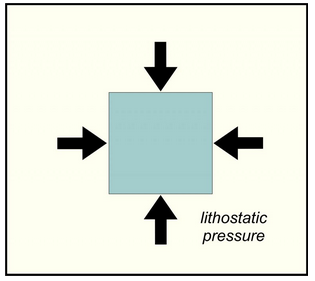8.2.2: Pressure and Depth
- Page ID
- 18605

After heat, pressure is the most significant cause of metamorphism. If pressure is applied to a rock, the rock may change size or texture, or perhaps develop new minerals to replace old ones. Burial causes rocks to experience lithostatic pressure, also called confining pressure. Lithostatic pressure is the same in all directions (Figure 8.18), and thus can cause an object to become smaller without altering its overall shape. This kind of pressure is equivalent to the pressure that swimmers feel on their ears when they go to the bottom of the deep end of a swimming pool. The pressure on a swimmer’s ears accrues because of the weight of water pushing down from above. Within Earth, the weight of rock, which is commonly three times denser than water, causes lithostatic pressure to build up quickly with depth. As shown in Figure 8.17, pressure of around 12 kbar is reached at 40 kilometers depth, although pressure depends, in part, on the density of overlying rocks. Although typical metamorphic rocks form at pressures of 0 to 10 kbars, we find higher pressure rocks in some places. These high-pressure rocks are rare because to get to very high pressure requires that rocks are buried to great depth – an uncommon occurrence. Subsequently, getting the rocks back to the surface so we can see them is even more problematic.


